Jeremy Guscott: Wales' vice-like defence fuels Six Nations Grand Slam run
- Published
- comments
Wales beat Scotland 18-11 to edge closer to the Grand Slam title
Wales roll on. Just as coach Warren Gatland predicted before the start of the Six Nations,, external his side have built up some formidable momentum after getting over the hurdle of France away on the opening weekend.
Eighty minutes against an excellent Ireland side now separates them from a 14th successive Test victory and, more importantly, a first Grand Slam since 2012.
Their performance against Scotland showed the qualities that their excellent run has been founded on.
The D in Wales' DNA
The most distinctive part of Wales' DNA is their defence. They have only scored nine tries so far in this tournament - the same number as Italy - but have conceded just six, the fewest of any side.
Their fitness, durability and organisation is more of a hallmark than incredible try-scoring.
Former Great Britain rugby league international Shaun Edwards has been in charge of their defence for more than 11 years and that continuity means the defensive system is ingrained.
Their ethos is to meet line speed with line speed. They come up flat and fast, especially close to the breakdown.
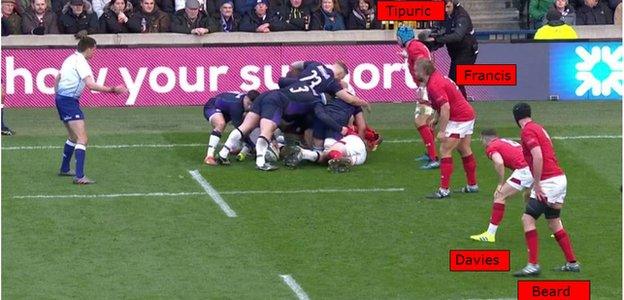
Here in the second half, Wales' first four defenders are well set, all watching for Scotland scrum-half Ali Price's pass
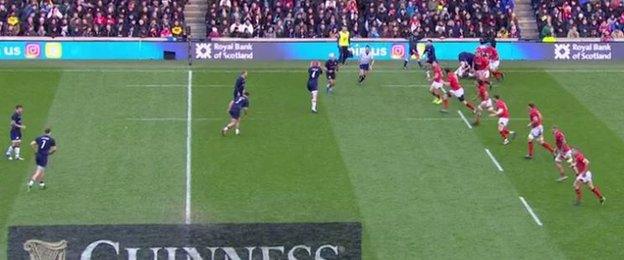
They lead out Wales' defensive line, putting pressure on first receiver Grant Gilchrist...
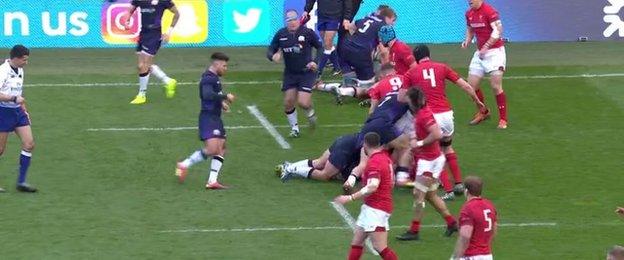
...and they haul him down just short of the gain line, with Scotland number five Jonny Gray still getting to his feet from the previous breakdown in the background
Individually, their first-up tackling is very good and, when that fails, their scramble defence is sharp and committed.
In the first half, Scotland wing Darcy Graham pinballed through Josh Navidi.

Wales second row Alun Wyn Jones has to change direction to chase the quicker man
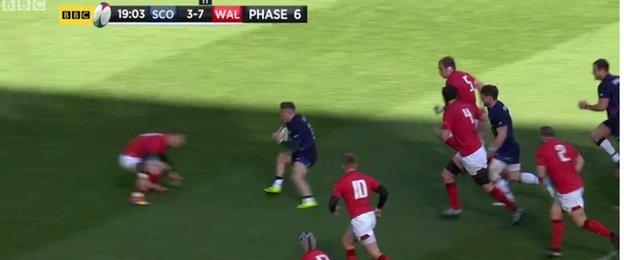
He is soon giving up a couple of metres to Graham....
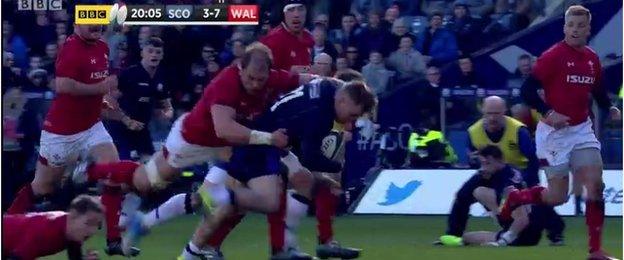
...but, with help from full-back Liam Williams' tap tackle, gets back to pull Graham to the floor
They also adapt to the opposition. Scotland wanted to play the game at high tempo, recycling quickly to spin wide before the defence was set but Wales were canny in preventing that, deploying the choke tackle to keep the ball off the floor and hold up play.
Out wide, Jonathan Davies is a key element in their defence.
They rely on his decision making to shut down the wide channels, anticipating where the ball will go and making a man-and-ball tackle or filling space effectively to jam up the opposition's gears.
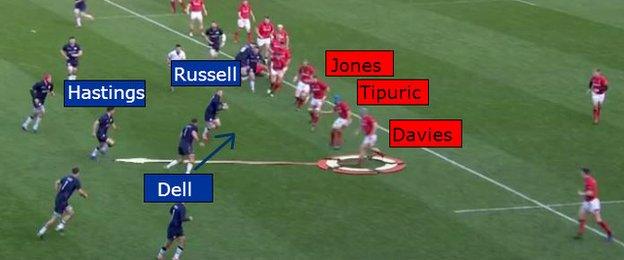
In this example, Finn Russell attempts to use Allan Dell's running line as a decoy to release Adam Hastings behind the prop...
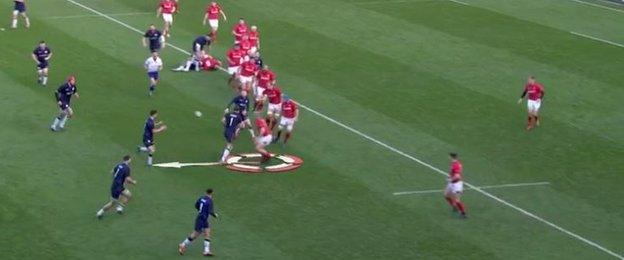
...but Davies reads his intention, zeroing in on Hastings...
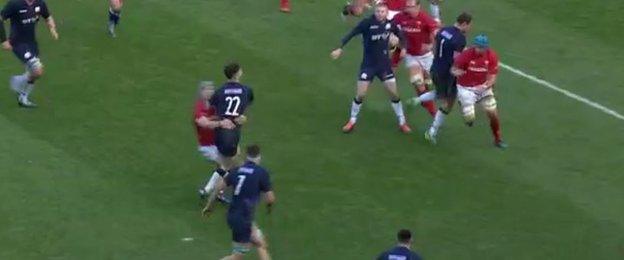
...and wrapping up his man
He reads the game incredibly well and rarely ends up in no man's land.
He is a keystone of Wales' defence and Scotland's only try came when they suckered him out of position.
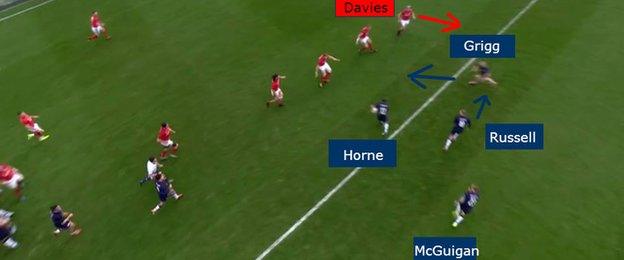
Davies, at the top of the picture, correctly anticipates Peter Horne's pass to Russell, who is wrapping around Nick Grigg's decoy run...
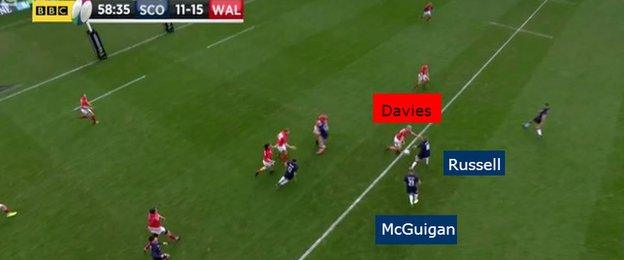
..but Russell's quick hands spring Byron McGuigan on a tracking line on his inside shoulder

McGuigan races into the hole left by Davies' rush out of defence and has Adam Hastings and eventual try-scorer Graham for support on his outside shoulder
It was a first-phase move that Scotland executed very slickly and it got its due reward.
Accuracy in attack
In attack, Wales are not a team to frighten the opposition with boundless creativity or individual brilliance. They don't threaten to steamroll you either, but they are relentlessly accurate. Like Exeter or Saracens in the English Premiership, they have a formula to get the job done and they can tweak it to suit the opposition.
Compared with the narrow game that they trumped England with, they clearly felt Scotland's defence gave them more latitude to get the ball wide.
Inside the first three minutes, Liam Williams had flicked on a pass with his fingertips to give Josh Adams a run down the right touchline.
Nine minutes later, on the opposite wing, Adams scored the opening try.
Wales got to the edge of the Scotland defence far too easily - Tommy Seymour stepped in when there was just no need.

Seymour and Russell need to trust their inside defence and cover the threat of Davies and Adams out wide
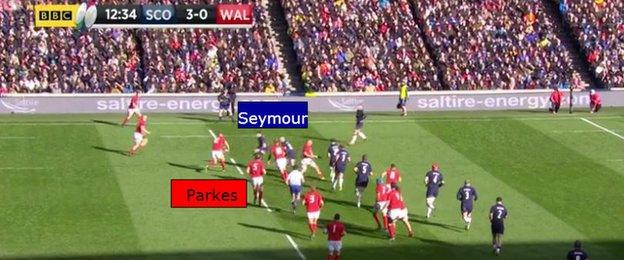
But Seymour is lured in by Parkes...
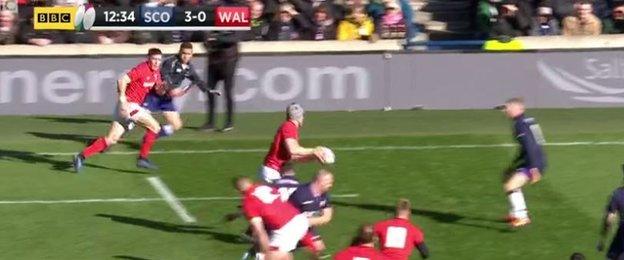
...leaving Russell exposed two on one
Among rugby players, wingers are occasionally characterised as having more fast twitch muscle in their legs than grey matter upstairs.
Seymour made a rash decision to come inside and that allowed Adams a one-on-one with Blair Kinghorn, who he sat down with a superb stutter step.
Josh Adams scores the first try for Wales against Scotland
Wales' second try was more reminiscent of the calm methodical way they ground down England's defence for Cory Hill's try two weeks ago.
England could not hit hard enough in defence to resist and Scotland certainly couldn't.
Next weekend promises to be a titanic match. While Scotland's personnel dictates their tactics, limiting them to one way of playing, Ireland are a much more rounded side.
They can meet the Welsh muscle up front with a host of heavy duty ball-carries, and the backline is more experienced and clinical than Scotland's.
Tale of two centres
England used the visit of Italy to Twickenham on Saturday to rest Henry Slade and instead pair up Ben Te'o and Manu Tuilagi as a heavyweight midfield duo.
Te'o has shone as a finisher for England, but I am yet to be convinced by him as a starter. He has not yet dominated a midfield, knocking people back in contact and linking with the man outside him.
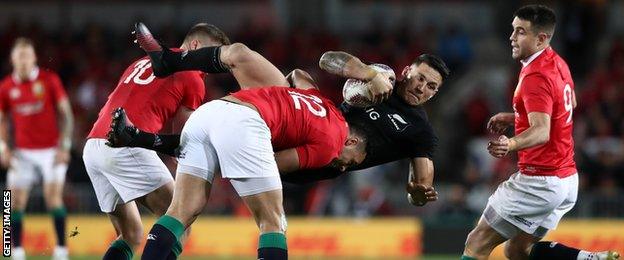
Te'o (12) had started only one England match before being named in the Lions XV for the first Test against New Zealand in June 2017
His best Test performance so far has probably come not for England but in the first Test for the British and Irish Lions in summer 2017 when he went toe to toe, pretty successfully, with New Zealand's Sonny Bill Williams.
He is still to build on that and there is more to come from him.
Manu Tuilagi had a more impressive game, punching big holes and scoring two tries against a poor Italy.
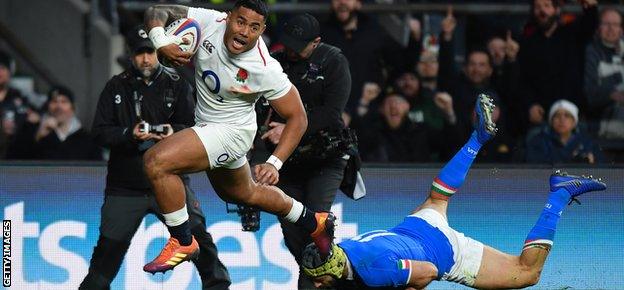
Tuilagi's two tries were his first international scores in five years
But the same could be said of him as of Te'o. At 27, he is still a player who can be developed. The template would be New Zealand great Ma'a Nonu. Nonu was not a great passing, kicking centre when he came into the All Blacks side, but by the end of his career his game management was superb.
He could kick long for field position, short for team-mates, offload out the tackle and link play. That is the extra dimension that Tuilagi could add to his express-train ball-carrying.
Team of the round
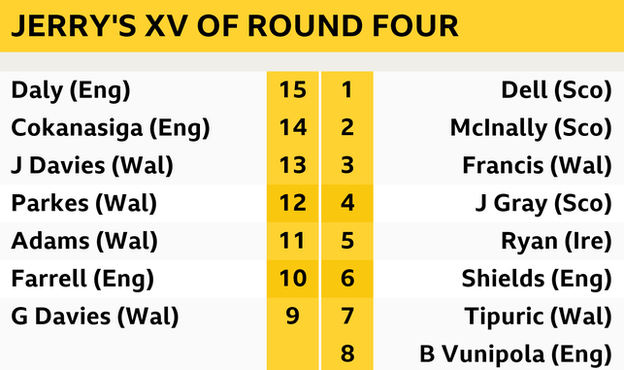
Jeremy Guscott was speaking to BBC Sport's Mike Henson.